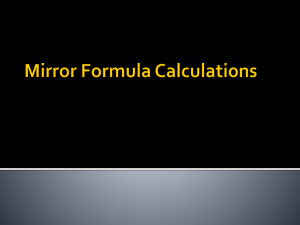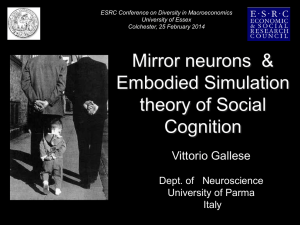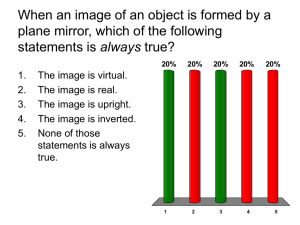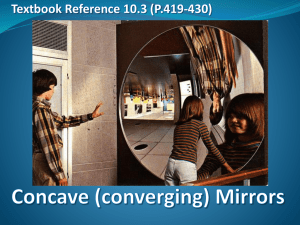26-SNC2D-MirrorAndMagnification
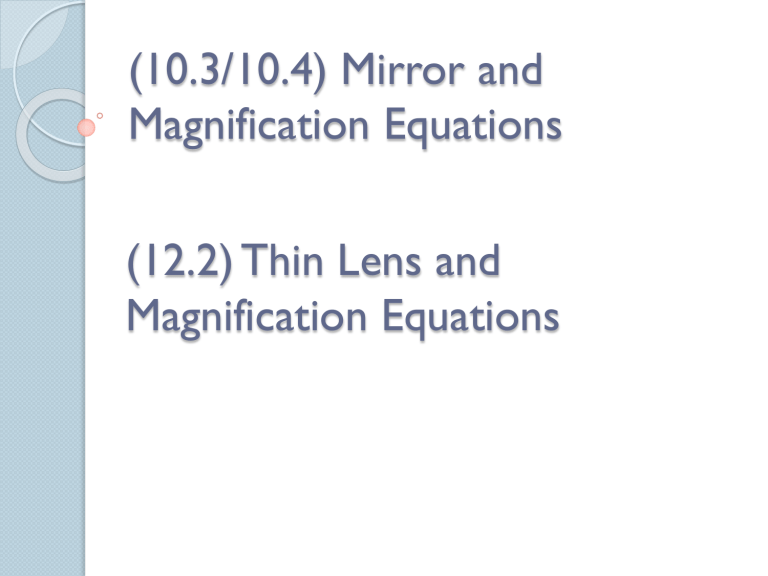
(10.3/10.4) Mirror and
Magnification Equations
(12.2) Thin Lens and
Magnification Equations
Mirror and Magnification Equations
The characteristics of an image can be predicted by using two equations:
◦ Mirror Equation:
Allows us to determine the focal point, distance of
the image, or the distance of the object
Must know two of the three variables in order to solve the third
◦ Magnification Equation:
Allows us to determine the height of the object or the height of the image.
This equation is usually used following the mirror equation
Mirror Equation
The mirror equation is seen below
◦ d o
◦ d i represents the distance of the object represents the distance of the image
◦ f represents focal length
Mirror Equation
If the image distance d i is negative, then the image is behind the mirror
(a virtual image)
• Example 1: A concave mirror has a focal length of 12 cm. An object with a height of 2.5 cm is placed 40.0 cm in front of the mirror. Calculate the image distance using GRASP. Is the image in front of the mirror or behind? How do you know?
•
•
Example 1: A concave mirror has a focal length of 12 cm. An object with a height of 2.5 cm is placed 40.0 cm in front of the mirror. Calculate the image distance using GRASP. Is the image in front of the mirror or behind? How do you know?
Given: f = 12 cm h o d o
= 2.5 cm
= 40.0 cm
• Required: d i
= ?
• Analysis:
1 + 1 = 1 d o d i f d i
1 = 1 - 1 f d o
•
•
•
•
•
Example 1: A concave mirror has a focal length of 12 cm. An object with a height of 2.5 cm is placed 40.0 cm in front of the mirror. Calculate the image distance. Is the image in front of the mirror or behind? How do you know?
Use GRASP …
Given: f = 12 cm h d o o
= 2.5 cm
= 40.0 cm
Solution:
1 = 1 1 d i
12cm 40.0cm
1 = 10 3 d i
120cm 120cm
Required: d i
= ?
1 = 7 d i
120 cm
Analysis:
1 + 1 = 1 d o d i f d i
1 = 1 - 1 f d o d i
= 120 cm
7 d i d i
= 17.14 cm
= 17 cm
Paraphrase
The image is 17 cm from the mirror. The sign is positive so the image is in front of the mirror.
Magnification Equation
The magnification (m) tells you the size, or
height of the image relative to the object, using object and image distances.
◦ Therefore, in order to use this equation the
distance of the object and image must be known.
Magnification Equation
If the image height h i is negative, the image is inverted relative to the object.
Example 2: A concave mirror has a focal length of
12 cm. An object with a height of 2.5 cm is placed
40.0 cm in front of the mirror. The image distance has been calculated to be 17.14 cm. What is the height of the image? Is the image inverted? Explain.
•
•
Example 2: A concave mirror has a focal length of
12 cm. An object with a height of 2.5 cm is placed
40.0 cm in front of the mirror. The image distance has been calculated to be 17.14 cm. What is the height of the image? Is the image inverted? Explain.
Use GRASP …
Given: f = 12 cm h d i o d o
= 2.5 cm
= 40.0 cm
= 17.14 cm
• Required: h i
= ?
• Analysis: h h i o
= - di d o
•
•
•
•
Example 2: A concave mirror has a focal length of
12 cm. An object with a height of 2.5 cm is placed
40.0 cm in front of the mirror. The image distance has been calculated to be 17.14 cm. What is the height of the image? Is the image inverted? Explain.
Use GRASP …
Given: f = 12 cm h d i o d o
= 2.5 cm
= 40.0 cm
= 17.14 cm
Required: h i
= ?
Solution: h i
= - 17.14 cm
2.5 cm 40.0cm
h i
= (- 17.14 cm) (2.5 cm)
40.0cm
h i h i
= -1.07 cm
= -1.1 cm
Analysis: h h i o
= - di d o
Paraphrase
The height of the image is 1.1 cm. The sign is negative , so the image is inverted.
Example 3: A convex surveillance mirror in a convenience store has a focal length of -0.40 m.
A customer, who is 1.7 m tall, is standing 4.5 m in front of the mirror.
◦ a) Calculate the image distance.
◦ b) Calculate the image height.
Answers: d i
= -0.37 m h i
= 0.14 m
Thin Lens and Magnification Equations
There are two ways to determine characteristics of images formed by lenses:
◦ Using ray diagrams
◦ Using algebra!
The Thin Lens and Magnification
Equations are the same as the mirror equations.
Thin Lens and Magnification Equations
Lens Terminology
d
0 d i
= distance from object to the optical centre
= distance from the image to the optical centre h
0 h i
= height of the object
= height of the image f = principal focal length of the lens
Thin Lens Equation
Sign conventions: d
0 is always positive d i is positive for real images and negative for
virtual images.
f is positive for converging lenses and negative for diverging lenses.
Magnification Equation
Sign conventions:
- Object and image heights are positive when measured upward and negative when measured downward.
- Magnification is positive for an upright image and
negative for an inverted image.
- Magnification has no units.
Example 1: A diverging lens has a focal length of
10.0 cm. A candle is located 36 cm from the lens.
What type of image will be formed? Where will it be located? Use GRASP.
Additional Problems
Questions 1-5 on page 427
Questions 1-7 on page 436
Questions 1-4 on page 500
